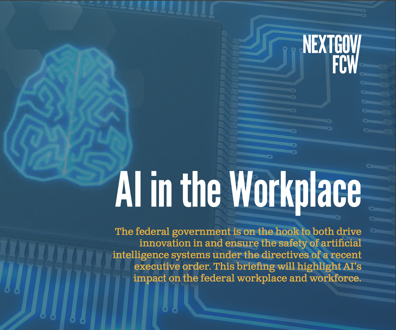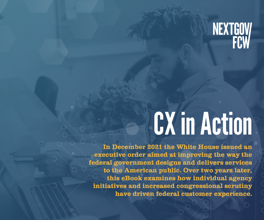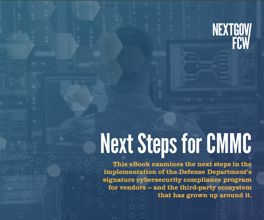Get ready for a seismic shift in federal IT

Daniel Hertzberg
Severe budget pressure and consumer technology are redefining both the workplace and the CIO's role.
Four years can change a lot in federal technology. As the Bush administration prepared to hand power to the Obama team in late-2008, no mission-critical government systems were housed in computer clouds, there were fewer than two dozen government-built mobile applications and the nation had never had a chief information officer.
Now new systems are moving to or being built in the cloud every month, there are more than 100 government apps and as for federal chief information officers—there have been two.
Four years ago, the idea that federal information technology contractors should provide three-, six- and 12-month deliverables rather than a fully completed system years down the road—called agile development—was gaining traction among some technology leaders, but was not a governmentwide mandate. And digital transparency was mostly about tools that sifted through email archives to respond to Freedom of Information Act requests, not the 400,000 public data sets agencies have now proactively posted online.
Changes of similar magnitude are sure to reshape federal IT during the next four to eight years, experts say, spurred on by shrinking agency budgets, the developing promise of cloud storage and advances in commercial technology that are influencing what both federal employees and citizens expect of government.
“It really doesn’t matter whether Romney wins or Obama wins, the budget pressures are going to be severe and agencies are going to have to figure out ways to get far more efficient than they are now,” Darrell West, director of governance studies at the Brookings Institution, said in mid-October. “The private sector has figured out ways to get more efficient by automating routine aspects of their organization and they’ve flattened organizations by cutting out a lot of mid-level managers. That involves using technology but it’s also about making organizational changes. You haven’t seen that as much from government yet.”
There is no crystal ball into the future of federal technology, of course, but the short list of emerging trends includes a seismic shift in the role of chief information officers, more collaborative technologies and a workplace that moves beyond ‘bring your own device’ to ‘bring your own everything.’
Trend 1: Empowering the CIO
First off, the next presidential term or two likely will shift the balance of power, both within the federal technology shop and between technologists and other workers. This could involve concentrating authority—including budget decisions—in the hands of agency CIOs. It is certain to involve broader responsibility as consumer technology becomes ubiquitous in government, as more employees work remotely on cloud-based platforms and as IT becomes another participant in nearly every government interaction—from videoconferences to shared documents to social media conversations.
More technology spending authority would fall to agency CIOs if Congress passes the Federal Information Technology Acquisition Reform Act, sponsored by Rep. Darrell Issa, R-Calif., chairman of the House Oversight and Government Reform Committee.
Issa’s proposed legislation, among the most significant federal IT rewrites since the 1996 Clinger-Cohen Act, also would shift the responsibility for certain specialized technology purchases to agency-based centers of excellence that have proven track records with those types of contracts.
If the reforms become law, they would lead to more careful monitoring of IT spending and a higher profile for CIOs among agency leadership, says Steve Charles, co-founder and executive vice president of ImmixGroup, a federal technology contractor.
“I think over the next 10 years we’re going to see a movement toward the CIO working more closely with the [chief financial officer] and the secretary of the department, all getting their arms around the IT spend,” Charles says. “More centralization means that there would be more adherence to the IT architecture. You’d have fewer pockets of people buying trinkets and toys and doing their own thing.”
In the current structure, only Veterans Affairs Department CIO Roger Baker has control over his agency’s IT budget. Most technology watchers agree that authority has been vital to his success in turning one of government’s most inefficient and wasteful IT shops into one of its more functional.
Any bill introduced into a Congress as beset by partisan divisions as the one beginning in 2013 is sure to face long odds. For Issa’s plan the “elephant in the room,” Charles says, is granting power over agency IT budgets to CIOs and wresting some of that power from House and Senate appropriations committees.
The bill does have a few points in its favor, however. First, there’s Rep. Gerry Connolly, D-Va., ranking member on the Oversight subcommittee that handles federal technology. Connolly has endorsed many of the bill’s underlying ideas and has said he’d like to work with Issa on the final product. Second, there’s a consensus across much of government, and in Congress too, that more efficient technology is about the only way agencies will be able to cut costs—a primary goal of both parties—without significantly reducing services. Smarter technology alone won’t be enough to deal with the steep budget cuts President Obama and congressional leaders agreed to in 2011, but it could prove the least painful part of any budget compromise.
Even if the IT Reform Act doesn’t become law, technology shops are likely to change in other ways, experts say, as a generation of professionals who grew up with Internet-based and cloud-based tools enters government service.
There are also new career paths in IT program management and records management mandated by the Office of Management and Budget. The industry group TechAmerica has advocated for a similar career path in data analysis.
Hiring will become easier as these IT posts become formalized, says Julie Anderson, a former deputy assistant secretary at VA and now chief operating officer at Civitas Group, a consultant for federal contractors. More important, she says, they will help new employees see a clear career path in government, which in turn will make it easier to retain talented staff.
“Particularly when young people come into government, they want that level of professional development and support,” Anderson says. “They may or may not be working for the world’s best manager in government, so the more information they have access to and the more process they understand, the higher the probability that they’ll be able to navigate the bureaucracy and turn their career path into a reality.”
Trend 2: Collaborative Tools
The face of federal technology likely will be changed by collaborative systems developed in the consumer sphere that are just now making their way into government.
These include social networks aimed at replacing interagency emails and phone calls with group chats, badges and polls. The General Services Administration already is using Chatter, a workplace social network from Salesforce.com, for some of its internal communications. The National Nuclear Security Administration plans to roll out a workplace social network next spring that ultimately could be adopted by the entire Energy Department.
One of the chief draws of a workplace social network is that problems thrown out to the crowd could pull in innovative answers from unexpected sources, Charles says. That could help break down agency silos and allow the most committed and talented workers to rise more easily through the bureaucracy.
In other cases, workplace collaboration may simply mean employees taking advantage of technologies such as Gchat, Google’s instant messaging program, and Google Drive, the collaborative document writing program, both of which come with the Google Apps for Government email systems, which GSA and other agencies recently adopted.
Collaborative document writing, videoconferencing and other adaptive technologies can facilitate cooperation between agencies or with industry and nongovernment groups, says Dan Chenok, vice president for technology strategy at the IBM Center for the Business of Government and former branch chief for IT policy at the Office of Management and Budget.
“At OMB, you deal with negotiated rule-makings where people come together and talk through all the issues and agree on a consensus for what the language ought to look like,” he says. “This is all done in large groups where everyone flies in. That may still need to occur when you’re dealing with some big, complex issues; you’re never going to lose the value of interpersonal relationships. But I think for a lot of issues you’ll begin to see more collaborative development as a way to save money and increase input and buy-in by a larger community.”
The goal for technology managers should be finding ways in which collaborative technologies can enhance communications without becoming a burden or an ill-fitting mandate, says Darren Ash, president of the American Council for Technology, part of ACT-IAC, an industry-government partnership with the Industry Advisory Council.
“People have different ways of working within the federal workforce,” says Ash, who is also CIO at the Nuclear Regulatory Commission. “So you have to design an ecosystem that accommodates all the different ways people have of learning and all the different ways people have of collaborating. Agencies need to think not necessarily about the particular collaboration tools but about the culture of their organizations. Will we really be able to foster and nurture collaboration with these tools? Will the culture adapt to them? Will the employees adapt to them and will they use them?”
Trend 3: Bring Your Own
The next four to eight years in federal IT will be defined by what workers increasingly lack, experts say, including agency-issued phones, tablets and even laptops for telework. “Bring your own device” policies already have been rolled out at some agencies, mostly on a voluntary basis. As the years go by and agency-issued BlackBerrys and other product lines wear out, those policies will become increasingly common and, in some cases, mandatory, experts say.
The most basic reason is efficiency.
“Apple just released the iPhone 5,” Ash says. “In the Android market it seems like a new model comes along every month. We can’t keep up.”
But there’s a deeper reason too. Just as the government doesn’t provide most employees with cars or Metro passes, some argue there’s no fundamental reason it should spend energy and resources providing them with cellphones when they’re perfectly willing to get one for themselves. In fact, many would rather choose the product they want. It’s a trope of technology conferences that many federal employees carry a government-issued BlackBerry in one pocket and a personal iPhone or Android in the other. Agencies have said they might offset this new employee burden with a stipend.
But resistance to a BYOD policy has been twofold. First, officials don’t trust iPhones and Androids to keep government information secure from hackers. Second, agencies aren’t sure they trust employees to not leave devices full of sensitive government documents sitting unsecured in the back seats of taxis or let children play Angry Birds on them.
Employees, for their part, don’t much like the idea of giving security officials power over their devices, which can be the equivalent of a personal diary, a calendar and a family photo album wrapped into one.
Officials are likely to crack these problems over the next administration or two, experts say. At the center will be a robust identity management system—one that knows who you are and where you are and that can keep work and personal information separate, says Karen Evans, e-government director during the George W. Bush administration. On the work side of the device, security officials would be able to control settings and remotely wipe away any data if the device was compromised, says Evans, who is now national director for the U.S. Cyber Challenge, an organization devoted to bringing more technology students into the public and private cybersecurity workforce.
An effective identity management system also would require a mobile-based biometric identifier, such as a fingerprint or iris scan, to reach classified or sensitive information, IBM’s Chenok says. That technology isn’t commercially available and there are no government standards for it, but it should be on its way within the decade, he says.
With BYOD, as with collaborative technologies and other advances, four or eight years might be long enough for the beginning of a culture change, but government moves like a battleship, not a speedboat, warns Charles at ImmixGroup. It will take a lot of pilot projects and a lot of time before the ship of state changes course entirely.
“Look at how long it took for management to start to take seriously the idea that you can legitimately telework,” he says. “That took five or six years at least. The same thing will happen with BYOD or BYO anything. The activities from one shop to the next are so disparate. The idea the whole government is going to wholesale change how everyone operates is ridiculous. The short answer is it’s going to happen piecemeal.”
Discuss the impact of these trends on the future of Federal IT with experts, innovators and your peers on Dec. 3 in Washington at Nextgov Prime, the defining event in the federal technology landscape. Learn more at nextgov.com/prime.
NEXT STORY: Some good post-Sandy cellphone news



